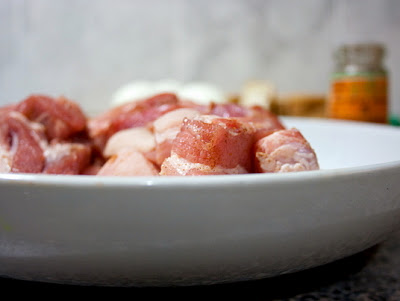If you are wondering what to do with the pot of poaching liquor after making soy poached chicken, here is the answer for you.
The method of braising meat in an aromatic soy stock called lu shui, 滷水 (popularly known as master stock in most English publications) originated in southern China centuries ago. It followed the migration routes of the Teochews (潮州人) and it is now a popular way of cooking in Taiwan and all over Southeast Asia.
It was quite common to visit a Teochew porridge restaurant after a night of drinking and dancing (during my younger days in Malaysia and Singapore). All sorts of simple dishes can be ordered to go with the pipping hot rice porridge, that would include different types of meat, poultry and tofu braised in lu shui of course.
P.S I served this when my friends J and G was over for a simple meal. J is Taiwanese and I can't think of a more appropriate MM dish that would cure her homesickness.
serves 4 to 6 as part of a Chinese meal
you'll need;
1.5 l of lu shui, 滷水 (aromatic soy poaching liquor*)
1.2 kg of pork belly, cut into large pieces
2 tsp of five spice powder
1 packet of tofu puffs, halved
6 hard boiled eggs, peeled
*if you haven't got the soy poaching liquor, this is what you'll need;
1 cup of light soy
1/2 cup of dark soy
6 cups of water
1/2 cup of rock sugar
1 cup of chinese cooking wine
5 cm knob of ginger, sliced
3 garlic cloves
1 spring onion (white part only)
1 cassia bark or cinnamon stick
2 star anise
1 tsp of Sichuan peppercorns
Cut pork belly into large pieces. Prepare the hard boiled eggs and tofu puffs.
Place pork belly in a large bowl and mix in the five spice powder.
Pan fry pork belly until golden and set aside. You may just blanch the pork belly before the next step but I like the texture after the frying process better.
Bring the lu shui to a boil then add in the pork belly. Turn it down to a very slow simmer and cook for 1.5 to 2 hours. Skim the surface of any scums to ensure a nice clean broth.
In the final 10 minutes of cooking, add in the eggs and tofu puffs. Check for seasonings.
Serve immediately as part of a Chinese meal. The sauce is more like a broth here and if you are after a sticky and thicker sauce, tau yew bak (soya sauce pork belly stew) might be what you are after.
My friend Sharon from Test With A Skewer is hosting the event for the month of July, please send all your entries to its.sharon@gmail.com. To find out more about MMM, please click here.












1.webp)






















Oh I love this with porridge!
ReplyDeleteWonderful recipe looks so tempting and inviting too...
ReplyDeleteThis looks absolutely tempting
ReplyDeleteI am going to try this with chicken as I really have to cut down on fatty food according to my dr.
ReplyDeleteMy kind of food! I have tried your soy chicken but I discharged the stock afterwards, next time I will have to try this.
ReplyDeletestumble this wonderful site by accident and like it a lot. I can't find where the post was so I just post here hope you don't mind! - tried the Asam Pedas fish with egg plant and okra. Since I was only cooking for 2 pax, I 'smartly' reduced the seasoning/spice paste accordingly. The result was a rather 'plain' dish. If done right, how the taste should like? In general. Is there is a 'formula' for adjusting the amount of seasoning/ingredient needed (more likely to reduce the servicing portion/size)?
ReplyDeleteI am stretching my luck here. I am kind of confused between Coriander (Yin Sai in chinese) and Celery (kan choy) in when to use it and for what. If you don't mind, of course. cheers
Hello! I'm a new food blogger from Philippines! :) http://eaternalfeast blogspot.com
ReplyDelete